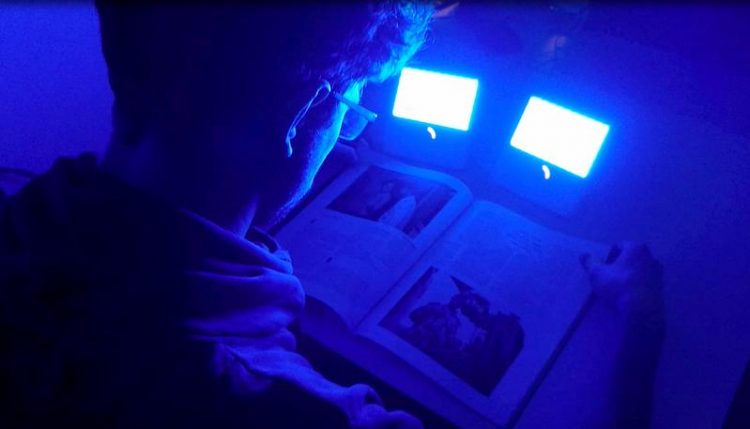Light Exposure in the Evening Improves Performance in the Final Spurt

Athletes in blue light: performance during the final spurt is clearly increased by light exposure. University of Basel, Department of Sport, Exercise and Health
Many sports events take place late in the evening, during television prime time. At this time of day, however, many athletes often fail to perform at their best due to their sleep-wake cycle.
In a study headed by Professor Arno Schmidt-Trucksäss, Raphael Knaier and colleagues at the University of Basel investigated whether light exposure before a cycling time trial can compensate for this disadvantage.
The Sports and Exercise Medicine division, as well as Professor Christian Cajochen at the Centre for Chronobiology, took part in this extensive investigation involving 74 young male athletes.
It is well known that blue light reduces the production of the sleep hormone melatonin. The researchers tested the hypothesis that this suppression of melatonin could improve an athlete’s endurance during a 12-minute cycling time trial.
They randomly divided the participants into three groups and exposed them to either bright light, blue monochromatic light or control light for an hour. This light exposure was immediately followed by the performance test on the bicycle ergometer.
Bright light is less effective
Exposure to blue light significantly improved the athletes’ ability to increase their performance during the final spurt of the time trial. This increase was defined as the ratio of the performance measured in the first minute to that of the last minute of the test. The subjects’ improved performance in the final spurt also correlated with the amount of blue light. This light was able to effectively suppress the melatonin and thus influence the athletes’ sleep-wake cycle.
Compared to the control light, bright light led to a small increase in overall performance, but the difference was not significant. “Since even minor differences are relevant in top-level sport, however, this should be investigated more closely in further studies,” commented Professor Schmidt-Trucksäss.
Original source
Raphael Knaier, Juliane Schäfer, Anja Rossmeissl, Christopher Klenk, Henner Hanssen, Christoph Höchsmann, Christian Cajochen, and Arno Schmidt-Trucksäss
Prime Time Light Exposures Do Not Seem to Improve Maximal Physical Performance in Male Elite Athletes, but Enhance End-Spurt Performance
Frontiers in Physiology (2017), doi: 10.3389/fphys.2017.00264
Further information
Professor Arno Schmidt-Trucksäss, University of Basel, Department of Sport, Exercise and Health, Tel. +41 61 207 47 41, email: arno.schmidt-trucksaess@unibas.ch
http://journal.frontiersin.org/article/10.3389/fphys.2017.00264/full Original source
Video: https://www.youtube.com/watch?time_continue=6&v=eWCwF0oiBUo
Media Contact
All latest news from the category: Life Sciences and Chemistry
Articles and reports from the Life Sciences and chemistry area deal with applied and basic research into modern biology, chemistry and human medicine.
Valuable information can be found on a range of life sciences fields including bacteriology, biochemistry, bionics, bioinformatics, biophysics, biotechnology, genetics, geobotany, human biology, marine biology, microbiology, molecular biology, cellular biology, zoology, bioinorganic chemistry, microchemistry and environmental chemistry.
Newest articles

A universal framework for spatial biology
SpatialData is a freely accessible tool to unify and integrate data from different omics technologies accounting for spatial information, which can provide holistic insights into health and disease. Biological processes…

How complex biological processes arise
A $20 million grant from the U.S. National Science Foundation (NSF) will support the establishment and operation of the National Synthesis Center for Emergence in the Molecular and Cellular Sciences (NCEMS) at…

Airborne single-photon lidar system achieves high-resolution 3D imaging
Compact, low-power system opens doors for photon-efficient drone and satellite-based environmental monitoring and mapping. Researchers have developed a compact and lightweight single-photon airborne lidar system that can acquire high-resolution 3D…





















